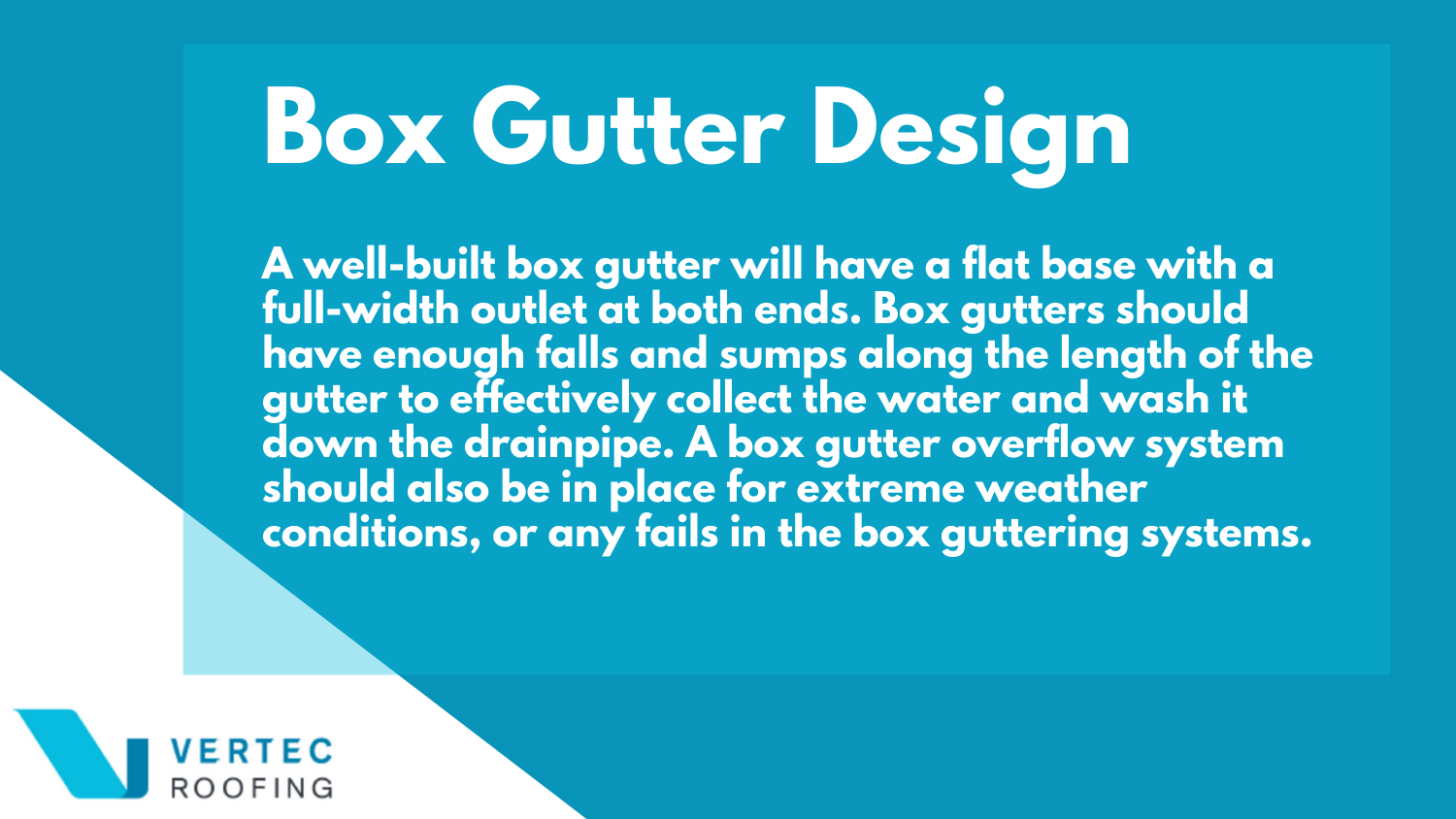

Understanding what is a box gutter is an essential asset for roofing professionals and other tradespeople. Box gutters can also be known as trough gutter, parallel gutters, or internal gutters. But precisely what is a box gutter? As the leading providers of the roofing services Sydney locals have trusted for over 20 years, Vertec are experts on all types of gutter systems within roofs, including box gutters. In this article, we’ll help you understand box gutters and the way they work.
A box gutter is a type of gutter that sits between two parallel parts of a roof. The box gutter between two roofs act as a valley between the two surfaces and collect drain water. However, box gutters should not be confused with valley gutters. Rainwater from both roofs (or parts of the roof) feeds into the box gutter. The box gutter drains the water away via downpipe nozzles or sumps that have downpipes built into it. A box gutter aims to channel rainwater from the roof to external parts of the building through a downpipe or the box gutter overflow system. Box guttering systems typically feature on the roofs of commercial buildings. However, they are also in some residential homes.
Most tradespeople will be aware of what is a box gutter, and what it looks like; however, it’s not common knowledge to most as they are not visible from the outside. Box gutters are typically long rectangular shaped channel-like structure that sits within the framework of the building. Box gutters have a flat, square-shaped base and high sides, much like the shape of a long rectangular box. The size of a box gutter between two roofs will depend on the size, shape and type of property. The best box gutter material to use is stainless steel or Colourbond for their durability.
Whilst box gutters were initially used in older commercial establishments and between terrace homes, they have risen in popularity in recent years for cosmetic purposes. Many modern homes or other commercial buildings use box gutters vs regular gutters. Box gutters do not sit on the house’s perimeter or establishment and are not visible from the outside of the property. Consequently, they can also be referred to as “concealed gutters” and create a seamless finish in buildings.

If you’re learning about what is a box gutter, it’s essential to consider the design of a box guttering system. Good attention to box gutter detail and design will lead to a discrete gutter system that is fully functional and looks great from the outside. However, poor design will lead to poor box gutter overflow management. A well-built box gutter will have a flat base with a full-width outlet at both ends. Box gutters should have enough falls and sumps along the length of the gutter to effectively collect the water and wash it down the drainpipe. A box gutter overflow system should also be in place for extreme weather conditions, or any fails in the box guttering systems. The overflow system means that water will overflow externally rather than flood the roof cavity.
Box gutter material must be considered in the design to ensure you select the most sustainable and strongest matter. Stainless steel or Colorbond is the best type of material chosen for the gutter itself. Box gutters are lined with EPDM rubber, metal, asphalt, or roofing felt. The cost to line box gutters that are damaged is approximately $20-$50 per linear foot, depending on the job’s complexity. The cost to line box gutters that are newly established is an extra $70-$100 per linear foot.
When understanding what is a box gutter, it’s essential to consider the difference between a box gutter and a regular gutter. The technical name for a standard gutter is an eaves box gutter. An eaves gutter is a type of gutter system fixed to the eave or fascia of the roof. They catch the water that runs off the sides of the roof and drain the water away through a drainpipe. Eaves gutters are the most common type of gutter that is visible on residential properties. There are three distinct differences in box gutters and eaves gutters, which we will outline below:
1. Box gutters are concealed from the outside, whereas eaves box gutter is visible from the outside of the building.
2. Box gutters are fixed within the building’s structure, whereas eaves gutters are fixed to the perimeter of a roof.
3. Box gutters are most commonly found on commercial buildings; however, they are occasionally added to residential properties for cosmetic purposes.

Understanding what is a box gutter and what makes a good box gutter is an essential part of any tradesperson or roofing professional’s knowledge. However, it’s also crucial that the managers understand the differences between box gutters and regular gutters. At Vertec, we focus on delivering a high-quality customer experience, and our helpful, professional team are ready to take your call. For further information or to boon installation, repair or maintenance, don’t hesitate to contact us today.

At Vertec Roofing, we believe roofing is about protecting homes and enhancing comfort.